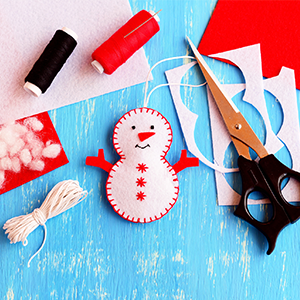December may be the busiest month of the year, but it’s also one of the
best times to take part in craft activities with your kids. Before the
hustle and bustle of the season sweeps you into the New Year, get your
children involved in these metal-making, taste-tempting, glimmery-glowing
activities. Then watch their faces radiate at what their hands have made.
EASY-AS-PIE ORNAMENTS
Supplies
- Disposable foil pie pan
- Holiday cookie cutters or stencils
- Permanent markers
- Scissors
- Assortment of sequins, rhinestones, craft jewels, etc.
- Glue
- Hole punch
- Ribbon
Instructions
-
Lay a cookie cutter or stencil on the inside of the pie pan and trace
around the design with a marker. -
Cut out this shape with scissors.
-
Decorate it with permanent markers and attach sequins, rhinestones
and/or craft jewels with glue. Let it dry. -
Punch a hole near the top of the ornament and string a ribbon through
it.
SWEET STUFFIN’ GINGERBREAD MAN
Supplies
Roll of brown Kraft paper (or large brown paper bag cut open so it lays
flat)
Scissors
Stapler
Markers
Buttons, rickrack, other sewing notions
Glue
Wrapped candy
Hole punch
Ribbon
Instructions
-
On a large piece of brown Kraft paper, draw a gingerbread-shaped man
that is approximately 15 inches long. Cut this out and use it as a stencil
to make a duplicate. -
On one of the men, draw a face with markers. Glue on buttons, rickrack
and other notions to decorate the body, arms and legs. -
Place the two gingerbread bodies together and staple around all of the
sides, leaving a 3-inch opening. Stuff the inside with candy (note you can
also add small toys, trinkets, money and goodie coupons). -
After you have filled the man, seal the opening with staples.
-
Punch a hole in the top of the gingerbread man, thread a ribbon through
it and hang. -
Choose a special day to break open the gingerbread man so everyone can
have a sweet treat.
GLIMMER ‘N GLOW LANTERNS
Supplies
- Colored construction paper
- Large canning jar
- Scissors
- Glitter
- Glue
- Tape
- Tea light
Instructions
-
Measure and trim a piece of construction paper to be as tall as the
canning jar and long enough to wrap around it. -
Fold the trimmed paper in half lengthwise and, starting from the folded
end, cut slits about ½ inch apart that go across the paper to about
½ inch from the outer edge. -
Open the paper and lay it flat.
-
Place dots of glue randomly around the paper and sprinkle glitter over
it. Shake off excess glitter and let it dry. -
Wrap the paper around the jar, fastening the bottom end with tape.
Slightly push down the paper from the top so the slits open out and tape
around the top of the jar. -
Place a tea light inside the jar. Light the wick and watch it glitter
and glow!
You light up my life …
Candles are a part of many holiday celebrations and have been around for
more than 5000 years. Historians believe the first candles were made by
Ancient Egyptians, who soaked reeds in melted animal fat to make torches.
It was the Romans, however, who are credited with developing the first
wicked candle. During the Middle Ages, beeswax candles were introduced in
Europe, but they were so expensive only the wealthy could afford them.
Paraffin wax was introduced in the 1850s, making candles more practical and
popular. But forty years later, when the light bulb was introduced, candle
making declined. The industry regained popularity during the first half of
the twentieth century. Then in the mid-1980s sales spiked when they became
available in various shapes, sizes, colors and scents.
Multicultural month …
During the month of December, various cultures observe traditions that
represent their values and beliefs. But how did these holidays begin? Check
out these websites to learn the history of different celebrations, along
with fun factoids about the origins of decorations, recipes and celebratory
items. Then pick up these children’s books to read stories based on some of
these observances.
Websites
Books
- “B is for Bethlehem: A Christmas Alphabet” by Isabel Wilner
- “Christmas in the Barn” by Margaret Wise Brown
- “Hanukkah at Valley Forge” by Stephen Krensky
- “It’s Kwanzaa Time!” by Linda and Clay Goss
- “Seven Spools of Thread: a Kwanzaa Story” by Angela Shelf Medearis
- “The Stone Lamp: Eight Stories of Hanukkah through History” by Karen Hesse

